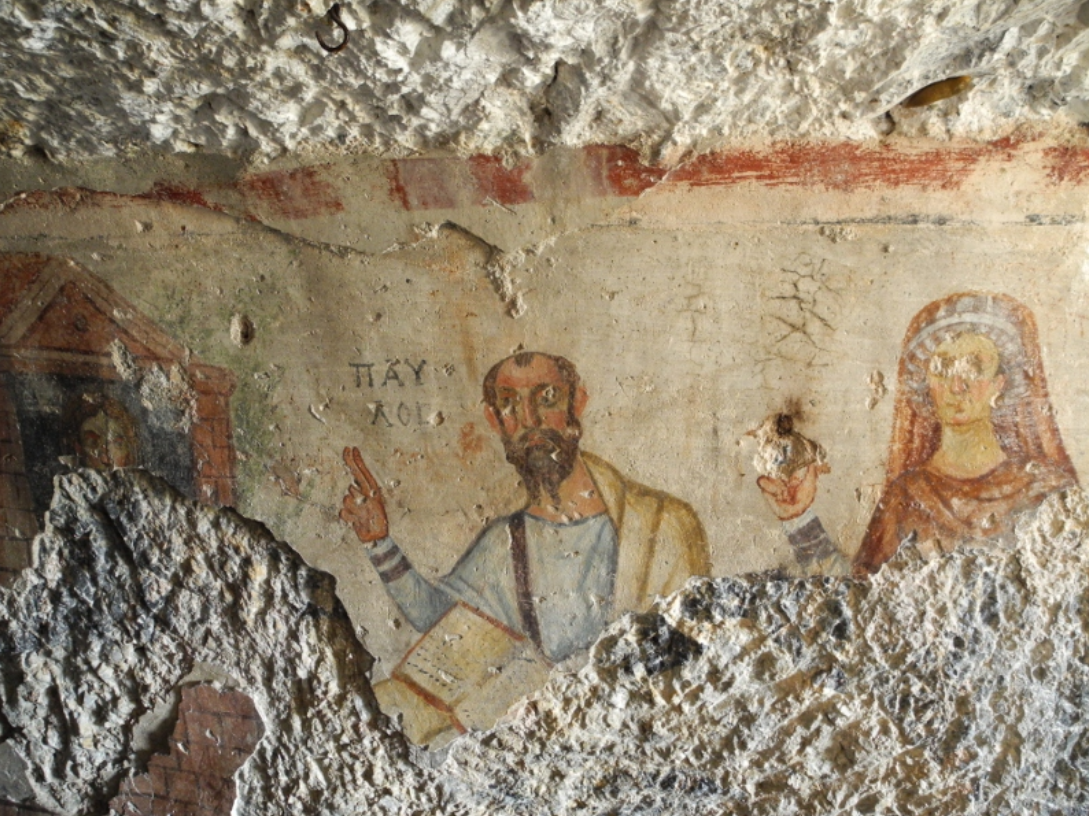Paul and Thecla: Feminist Fantasy?
Fresco of Paul and Thecla. https://www.flickr.com/photos/davidjlull/6002320425
Since the 1980s, the late-second century apocryphal text entitled the Acts of Paul and Thecla (APTh) has captured the imaginations of many, including scholars, laypeople, feminists, and combinations of all three. Originally understood as a constituent part of the longer Acts of Paul, many were drawn to the story of the Iconian noblewoman Thecla - who rejected her fiancé in order to follow the gospel – contained within the pages of the longer text. It’s easy to see why the story of Thecla was considered separate to the Acts of Paul: not only was it preserved separate from the longer text in Greek and Coptic forms, of the forty-three chapters following Thecla’s conversion, Paul only features in nineteen. The central character of this episode is clearly Thecla.
The centrality of this female character, her rejection of her husband in her commitment to the gospel, and her protection by the feminine (especially in the Antioch episode, with her virtue being protected by queen Tryphaena and her life being protected by a fierce lioness sent to destroy her) has predictably attracted attention from feminist scholars, as well as scorn from those who understand the work to be decidedly anti-feminist, arguing that the APTh centres around a young girl’s love for an itinerant madman who later abandons her, and is inordinately concerned with her virginal status.
In terms of contemporary reception, the work was rejected by Tertullian in his work On Baptism, citing the author as an orthodox presbyter with love for Paul, who fabricated the story. It must be noted that Tertullian’s reason for rejecting the APTh as genuine was due to the fact that Thecla baptises herself, as Tertullian argued that women should not be permitted to baptise themselves or others.
The question of whether or not the APTh can be considered feminist is not only anachronistic but entirely dependent on qualities one considers necessary for a text to be ‘feminist’. The APTh does centre around a young girl who rejects social standards of marriage, risking her life to follow the gospel, and who is protected by women and female creatures in the Antioch episode.
In her commitment to the gospel, Thecla refuses to bow to the pressures of Roman society, risking her life in the process. However, one argument against the feminist reading of this text is the centrality of Paul and Thecla’s commitment to him, even after his apparent betrayal in Antioch.
There have been comparisons between the APTh and ancient romance literature because of this: are Paul and Thecla a kind of ancient romance-type coupling? Thecla’s reaction when encountering Paul for the first time is typical of ancient romance literature, especially Joseph and Aseneth and the later Ethiopian Tale. She is clearly enamoured with the apostle in some way.
It has been argued that her visitation of Paul in prison has been cited by commentaries as somewhat erotic, given that she kisses his chains and is found at daybreak “bound [with him] in affection”.
Furthermore, Paul and Thecla avoid persecution in Antioch by lying, just as other couples in the ancient romance genre do: in the Ethiopian Tale, for example, the central couple claim to be siblings to avoid being separated. However, adherence to tropes of the ancient romance genre should not be taken as indications that the APTh is an ancient romance text. This interpretation risks infantilising Thecla (as much as it is possible to infantilise a child) as a teenager with a “crush” on Paul.
This isn’t to say that the APTh doesn’t share similarities with the ancient romance genre. The main tropes of the genre are there: when the couple are introduced, there is a love-at-first-sight-type reaction from one party, usually the female; the couple undergo strenuous and life-threatening testing; and finally the couple are re-united, their commitment tried and true by the hardships they endured, and the relationship is consummated, usually within marriage.
However, it must be recognised that it is not Thecla’s commitment to Paul that is the object of these ancient romance tropes, but her commitment to her faith, of which her chastity is a natural offshoot. The APTh contains one of the most detailed early descriptions of Paul, describing him in physiognomically uncharitable terms, and also makes a point of describing Thecla did not seeing Paul at first, only heard him preaching. Thecla’s reaction, therefore, is comparable to the reaction of Aseneth upon seeing her betrothed: a reaction to the gospel, not to Paul.
Her commitment to chastity is threatened and tested by attempted executions. The consummation of the relationship is not marriage, but self-baptism and ratification by Paul. The APTh does cleave to ancient romance tropes, but presents a different kind of partner. By comparing the compelling power of the gospel to the literarily well-established power of love, the author of the APTh draws upon relevant cultural understandings to communicate their evangelistic message.
In light of this, is it justified to understand the text as feminist? Again, this is dependent upon one person’s understanding of feminism. On my own understanding, the answer is a hesitant ‘yes’: the APTh tells the story of a woman, so taken with the gospel, that she casts off the expectations of her family and her society in order to follow it, risking her life in the process.
Thecla follows the call to self-determination, in this case the call to follow Christ and remain a virgin. She is vindicated by various miracles and signs in the process. The APTh is far from necessary feminist reading, but shows that early Christian apocryphal literature did, consciously or unconsciously, concern itself with the self-determination of its converts against the expectations of their society. In this light, it is unsurprising that Thecla stands as a model convert.


